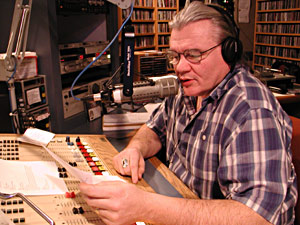|
Audio
Photos
Resources
Your Voice
|
Cultural broadcasting: Radio show a rare outlet for Indian voices and music
February 6, 2003
Aside from a handful of radio stations based on Indian reservations, programs featuring Native American music and voices are few and far between. For 10 years, St. Cloud State University has hosted one of these rare programs.
St. Cloud, Minn. — The signal reaches Indians and non-Indians around central Minnesota, from groups of small children in Milaca to octogenarian veterans at the St. Cloud V.A. medical center. Every Monday night at 5, Anishinabe O'denong goes on the air, and St. Cloud State University's community radio station turns its basement studio over to Gary Johnson Cheeseman.
"Well there you have it, you found us, it's Anishinabe O'denong on KVSC, your sound alternative," Cheeseman says, welcoming listeners to the two-hour show. "Daki ayaa, it's cold outside today, but it's better than it has been."
|
She was weeping over the radio, so ecstatic to hear some of her own people out in this area.
- Gary Johnson Cheeseman |
Cheeseman punctuates his relaxed commentary with small bits of Ojibwe, and there's much more native language in the music he plays. The 41-year-old volunteer host is part Ojibwe, part Abenaki, part Micmac and part Irish. He started Anishinabe O'denong 10 years ago as a student; today he teaches Ojibwe at St. Cloud State.
Cheeseman describes the meaning of the show through the story of an Indian woman who had just moved to the area. Her husband died soon after they arrived, and one lonely evening she was flipping through the radio frequencies for company.
"The woman called me up and said that she just couldn't believe it, and she was weeping over the radio, so ecstatic to hear some of her own people out in this area," Cheeseman said. "So she's a listener that we have every Monday night."
The name of the show refers to a generic small Indian town. Cheeseman tells listeners he's broadcasting from the bingo hall on the rez, and tells his weekly "Stories from O'denong," many of which come from personal experience. At least one recurring character makes an appearance every week.
 | |||
"Whenever you go to a reservation, you'll see a ton of dogs running around," he said. "And they're all silly dogs, they're silly-looking dogs. But they all have their own character." On-air, the sound-effect of a growling dog signals a weekly feature. "Here's comes our buddy, Whitey the Rez dog," Cheeseman says. "As you know, he's part German shepard, part bassett hound, part chihuahua, and part squirrel. And he always brings in our 'Rez dog riddle of the week.'"
Cheeseman is looking out for his Indian audience, which he guesses is about 30 percent of those who listen. A syndicated newscast rounds up Indian-related stories from around the country; pre-produced public service announcements on diabetes reach out to a community with distinct needs.
"Nothing more important than Indian people out there controlling their diabetes," Cheeseman tells listeners. "Frankly I don't know many elders out there who don't have diabetes, so let's all take care of our older population."
|
We'll play any kind of Indian music. We like the diversity, stuff from the Southwest, from the Southeast, Alaskan music, Minnesota music, whatever people want to hear.
- Gary Johnson Cheeseman |
Cheeseman spends more than half the show spinning CDs. Native music comes in all colors, from all over the country, from drumming to rock to jazz and even rap. Promo CDs don't exactly roll in through the mail, and Cheeseman has to actively seek out the variety he needs. It's when he is choosing music for the show that he is most aware of the difference in Indian and non-Indian tastes.
"I think people who come from the culture like to hear more culturally-based music. Music from the powwows, more of the drum music," he said. "Whereas people who aren't used to drum music go for more pop-sounding music, more flute music."
Cheeseman doesn't set out a social mission for the show, but knows he plays an important role. "What I try to do is put a human face on Indian people, to get people to know Indian people indirectly through their music, through the stories, through the cultural makeup that we try to create."
Occasional complaints from those who didn't like the show stopped after the first couple of years, but Cheeseman knows there is still tension between Indians and non-Indians in Minnesota, and has experienced some himself. "We're in an area of the country where we have racial issues, and people who are discontent for various reasons," he said. "And you basically have to find a way to deal with those issues. Won't stop me. I'll be here."
Cheeseman believes the audience for the show is growing. As long as there's someone listening, he says, he'll be in the studio for them each Monday night.
|
News Headlines
|
Related Subjects
|

